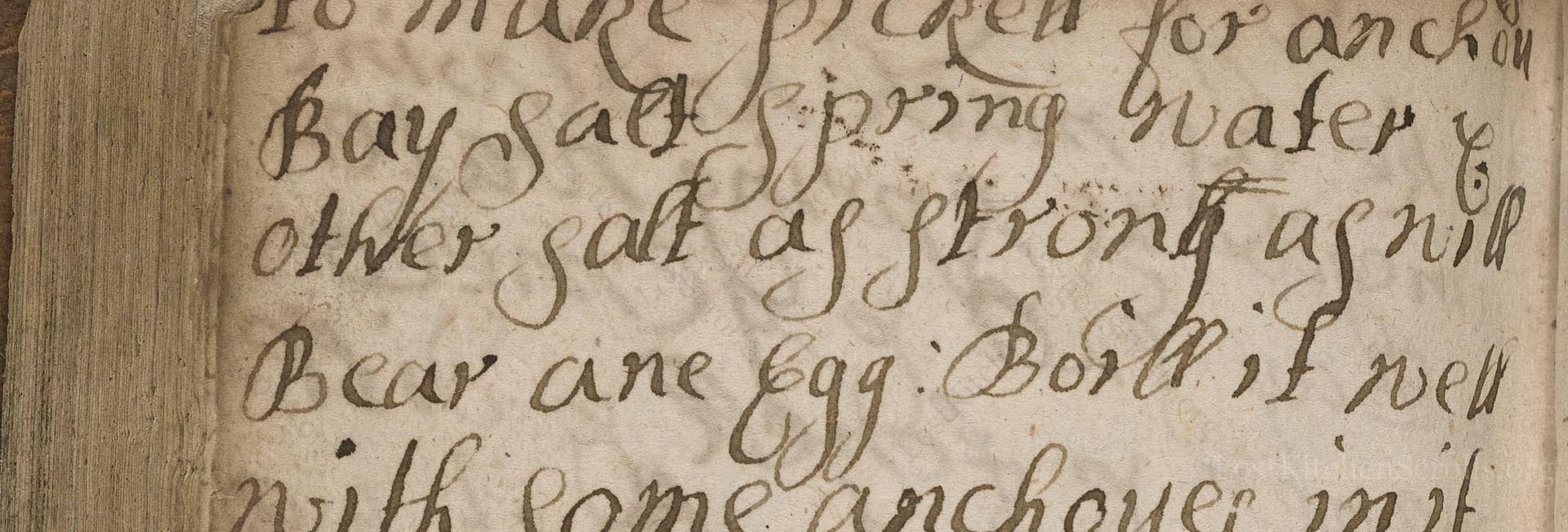To Make Pickell For Anchovs
From the treasured pages of Medicinal and cookery recipes by Katherine Brown
Written by Katherine Brown

To Make Pickell For Anchovs
"Bay Salt & spring Water & other salt as strong as nil Bear an Egg: Boil it well with Some anchoues in it"
Note on the Original Text
Historical recipes from this era were written as brief instructions, assuming the reader understood basic kitchen procedures. Spelling was fluid ('pickell,' 'anchovs'), and measurements were vague or omitted, relying on physical tests (floating an egg) rather than weights or volumes. The language is direct, and the process is implied—ingredients, a method, and a practical test for readiness, all in a condensed format.

Title
Medicinal and cookery recipes by Katherine Brown (1656)
You can also click the book image above to peruse the original tome
Writer
Katherine Brown
Era
1656
Publisher
Unknown
Background
A charming 17th-century collection of culinary secrets and recipes, Katherine Brown’s handwritten compendium invites readers to savor the flavors and methods of England’s past, where each page serves up a delicious taste of history.
Kindly made available by
Folger Shakespeare Library
This recipe hails from mid-17th century England, specifically the household manuscript collection compiled by Katherine Brown around 1650–1662. During this period, the art of pickling and preserving foods was essential for year-round provisions, especially for fish like anchovies, which were highly prized and often imported from the Mediterranean. Bay salt, a coarse salt evaporated in bays, was commonly used for preservation. The recipe reflects both domestic ingenuity and the cosmopolitan reach of English kitchens at the time.

The preparation would have required a large earthenware or metal pot for boiling, a wooden spoon for stirring, and standard kitchen knives. A ceramic or glass jar for storing the finished pickle, and perhaps a weight or plate to keep the anchovies submerged. Eggs were used as a practical 'salinity tester'—if the brine can float an egg, it is salty enough for effective preservation.
Prep Time
5 mins
Cook Time
10 mins
Servings
10
We've done our best to adapt this historical recipe for modern kitchens, but some details may still need refinement. We warmly welcome feedback from fellow cooks and culinary historians — your insights support the entire community!
Ingredients
- 9 ounces coarse sea salt (as substitute for bay salt)
- 4 1/4 cups fresh water (spring water or filtered water)
- 1 hen's egg (for brine testing, not consumed)
- 1 3/4 ounces anchovies (salted or fresh, for boiling in brine)
Instructions
- To make a brine for anchovies, combine bay salt (or coarse sea salt) and fresh water.
- The instructions advise mixing enough salt with spring water to create a strong brine—so strong that a fresh egg floats on the surface.
- Once the brine is ready, bring it to a gentle boil and add a few anchovies.
- Let this mixture simmer briefly to both flavor the brine and ensure it is well-infused.
- Strain and cool before using it to preserve or flavor anchovies, or as a table condiment.
Cooking Estimates
Preparing the ingredients and workspace takes about 5 minutes. Bringing the brine to a boil and simmering the anchovies takes about 10 minutes. The brine is not meant to be eaten, so calories per serving are close to zero.
As noted above, we have made our best effort to translate and adapt this historical recipe for modern kitchens, taking into account ingredients nowadays, cooking techniques, measurements, and so on. However, historical recipes often contain assumptions that require interpretation.
We'd love for anyone to help improve these adaptations. Community contributions are highly welcome. If you have suggestions, corrections, or cooking tips based on your experience with this recipe, please share them below.
Join the Discussion
Rate This Recipe
Dietary Preference
Main Ingredients
Culinary Technique
Occasions

Den Bockfisch In Einer Fleisch Suppen Zu Kochen
This recipe hails from a German manuscript cookbook compiled in 1696, a time whe...

Die Grieß Nudlen Zumachen
This recipe comes from a rather mysterious manuscript cookbook, penned anonymous...

Ein Boudain
This recipe comes from an anonymous German-language manuscript cookbook from 169...

Ein Gesaltzen Citroni
This recipe, dating from 1696, comes from an extensive anonymous German cookbook...
Browse our complete collection of time-honored recipes



